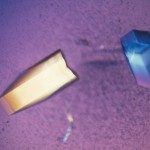Lien vers Pubmed [PMID] – 17608725
FEBS J. 2007 Jul;274(14):3704-14
Methylanthraniloyl derivatives of ATP and CDP were used in vitro as fluorescent probes for the donor-binding and acceptor-binding sites of human UMP-CMP kinase, a nucleoside salvage pathway kinase. Like all NMP kinases, UMP-CMP kinase binds the phosphodonor, usually ATP, and the NMP at different binding sites. The reaction results from an in-line phosphotransfer from the donor to the acceptor. The probe for the donor site was displaced by the bisubstrate analogs of the Ap5X series (where X = U, dT, A, G), indicating the broad specificity of the acceptor site. Both CMP and dCMP were competitors for the acceptor site probe. To find antimetabolites for antivirus and anticancer therapies, we have developed a method of screening acyclic phosphonate analogs that is based on the affinity of the acceptor-binding site of the human UMP-CMP kinase. Several uracil vinylphosphonate derivatives had affinities for human UMP-CMP kinase similar to those of dUMP and dCMP and better than that of cidofovir, an acyclic nucleoside phosphonate with a broad spectrum of antiviral activities. The uracil derivatives were inhibitors rather than substrates of human UMP-CMP kinase. Also, the 5-halogen-substituted analogs inhibited the human TMP kinase less efficiently. The broad specificity of the enzyme acceptor-binding site is in agreement with a large substrate-binding pocket, as shown by the 2.1 A crystal structure.


